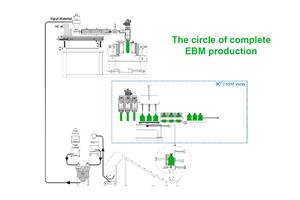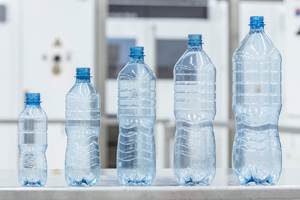Blown Film Line Combines Style, Substance
WEB EXCLUSIVE: Three years in the making, unique Varex II blown-film line from W&H that debuted at K 2013 features clean, sleek look and offers upgrades in throughput and control as well.
In blown film extrusion, one of the highlights of K 2013 was the introduction by Windmoeller & Hoelscher (U.S. office in Lincoln, R. I.) of the Varex II line. Three years in the making, the new system was tucked into a corner of W&H’s booth and accessible by invitation only. Even then, visitors had to be escorted through a curtain and around a cordoned corridor to see the system in action.
The line featured a sleek, completely enclosed design that several onlookers thought looked more like an Apple product than typical industrial equipment. There were no cables to possibly trip over or duct work or electrical wiring in sight. The extruders and die/air-ring package were cladded—but accessible for maintenance—in what looked like fine cabinetry. A lightweight air ring made of polycarbonate was insulated to mitigate the effects of condensation.
Throughout the show, W&H made five-layer shrink collation film at 40-micron thickness. Running with a 16-in. Maxicone P die, material was processed at 2200 lb/hr, or 44 lb/hr/in. of die circumference. The trimless system ran at a layflat width of 83 in. W&H has sold seven such systems in the U.S., two of which are seven-layer.
Varex II is available with working widths up to 142 in. and can be specified for up to 11 layers. At the show, W&H ran two 60- and 70-mm (about 2.5- and 3-in.) extruders along with a 105-mm (4-in.) machine. The size range also includes 50- and 120-mm (roughly 2- and 5-in.) extruders. Die diameters range from 120 to 900 mm (5 to 35 in.)
Extruders feature what W&H calls “flow-optimized” barrier screws to provide maximum flexibility for processing a wide range of materials. A patented melt-distribution system allows for compact design of the Maxicone P die while keeping pressure losses low. The die was equipped W&H’s Optifil P auto-gauge profile control system, which enables targeted controlof the melt temperature on the bubble circumference to reduce gauge variations.
The line also featured the Arctis high-performance, dual-lip air-ring system, an upgrade of W&H’s Opticool air ring that is said to boost output by 5-10%. The air ring’s position relative to the die can be adjusted to optimize blow-up ratio. A new bubble collapsing unit in the film hauloff features automatic adjustment of the lateral guide elements, which reportedly improves film flatness while minimizing film curvature. Featuring a comprehensive range of optional specifications, the new Filmatic S II winder can be tailored to any application.
The new system also is equipped with a 24-in. touchscreen interface that includes control modules aimed at helping film processors reduce waste and improve efficiency and sustainability. These include Easy-Change, an “autopilot” for size changeovers; Easy-Wind, a winder control concept for optimum roll quality; Profile-Booster, designed to accelerate line startup; and Purge Assist, for automatic purging of the extruders and dies.
Other automation modules include Energy Monitoring, which displays the energy usage of individual system components, identifying possible energy savings in the course of production. A web-based Production Planning and Control module permits decentralized job preparation and control. Order specifications and product formulations can be transmitted directly from a plant ERP system to the extrusion line, without the operator having to enter any order data locally on the machine.
Related Content
Thin, High-Performance Nylon/PE Barrier Film for Thermoformed Packaging
Südpack’s Multifol Extreme film is well suited for greasy, protein-rich and frozen foods
Read MoreGet Color Changes Right In Extrusion Blow Molding
Follow these best practices to minimize loss of time, material and labor during color changes in molding containers from bottles to jerrycans. The authors explore what this means for each step of the process, from raw-material infeed to handling and reprocessing tails and trim.
Read MoreFirst Water Bottles With Ultrathin Glass Coating
Long used for sensitive juices and carbonated soft drinks, KHS Freshsafe PET Plasmax vapor-deposited glass coating is now providing freshness and flavor protection for PET mineral water bottles.
Read MoreBreaking the Barrier: An Emerging Force in 9-Layer Film Packaging
Hamilton Plastics taps into its 30-plus years of know-how in high-barrier films by bringing novel, custom-engineered, nine-layer structures resulting from the investment in two new lines.
Read MoreRead Next
Beyond Prototypes: 8 Ways the Plastics Industry Is Using 3D Printing
Plastics processors are finding applications for 3D printing around the plant and across the supply chain. Here are 8 examples to look for at NPE2024.
Read MoreMaking the Circular Economy a Reality
Driven by brand owner demands and new worldwide legislation, the entire supply chain is working toward the shift to circularity, with some evidence the circular economy has already begun.
Read MorePeople 4.0 – How to Get Buy-In from Your Staff for Industry 4.0 Systems
Implementing a production monitoring system as the foundation of a ‘smart factory’ is about integrating people with new technology as much as it is about integrating machines and computers. Here are tips from a company that has gone through the process.
Read More












